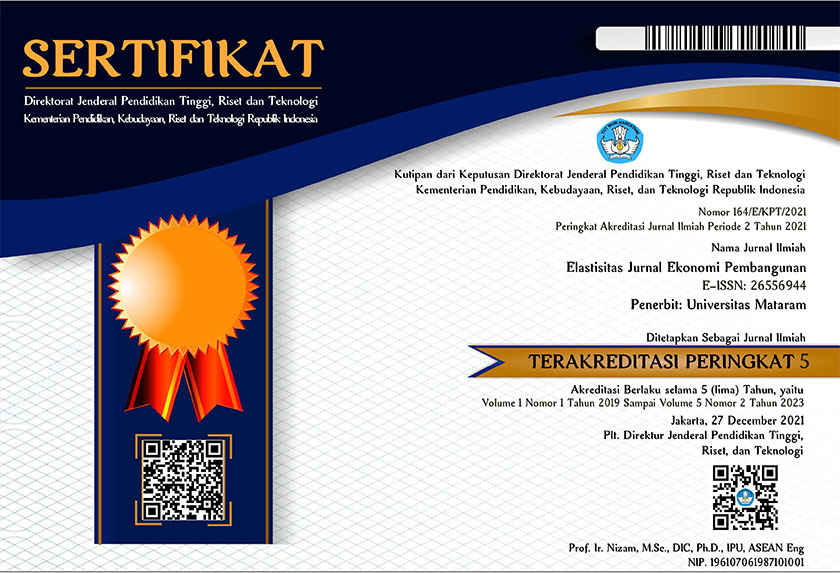TYPOLOGY ANALYSIS AND RELATIONSHIP BETWEEN STUNTING PREVALENCE, ECONOMIC GROWTH AND GRDP PER CAPITA IN PROVINCE OF BALI
DOI:
https://doi.org/10.29303/e-jep.v6i4Keywords:
Typology Analysis, Stunting Prevalence, Economic Growth, GRDP Per CapitaAbstract
This study aims to determine the dynamics of the growth pattern and structure of each city/regency in the Province of Bali and try to see its relationship with the stunting prevalence in the Province of Bali. The analytical method used in this research is the Klassen Typology analysis technique and the Spearman Rank Correlation. The results of the Klassen Typology analysis, when correlated with stunting data, show that the Buleleng area which is a developed area (quadrant 1) has a high stunting prevalence of 10.30%, while Tabanan is a relatively underdeveloped area (quadrant 4) has a stunting prevalence below the average Province of Bali (6.6%). The results of the correlation test with the Spearman Test showed that there was no significant relationship between economic growth and GDP per capita partially on the stunting prevalence in Province of Bali, but each of the two variables had a negative relationship. Thus, further research is needed regarding other facts regarding the stunting prevalence in the Province of Bali, so that it can provide a clear picture of the variables that influence the stunting prevalence in each district/city.
References
Badan Pusat Statistik Kabupaten Badung. (2023). Booklet Indikator Strategis Kabupaten Badung 2018-2022. BPS Kabupaten Badung
Beal, T., Tumilowicz, A., Sutrisna, A., Izwardy, D., & Neufeld, L. M. (2018). A review of child stunting determinants in Indonesia. Maternal and Child Nutrition, 14(4), 1–10.
Darma, D., Sari, P., Marwa, T., & Bashir, A. (2020). The causality between economic growth, poverty, and stunting : empirical evidence from Indonesia. 8(1), 13–30.
Hariyanto, M. V., & Purwanti, P. A. P. (2020). Analisis Pertumbuhan Ekonomi dan Indeks Pembangunan Manusia di Kabupaten/Kota Provinsi Bali (Metode Kointegrasi). Media Trend, 15(1), 52-61.
Ilman, assyifa S., & Wibisono, I. D. (2019). Analisis Harga Pangan dan Prevalensi Stunting di Indonesia. Center for Indonesian Policy Studies, 20, 1–17.
Firmansyah, M., & Astuti, E. (2021). Analisis Pola Dan Struktur Pertumbuhan Sektor Ekonomi Kota Mataram Dan Hubungan Kota Mataram Dengan Kabupaten Sekitarnya Di Pulau Lombok Propinsi Nusa Tenggara Barat. Elastisitas: Jurnal Ekonomi Pembangunan, 3(1), 17-25.
Karyati, Y., & Julia, A. (2021). Pengaruh Jumlah Penduduk Miskin, Laju Pertumbuhan Ekonomi, dan Tingkat Pendidikan terhadap Jumlah Stunting di 10 Wilayah Tertinggi Indonesia Tahun 2010-2019. Jurnal Riset Ilmu Ekonomi Dan Bisnis, 1(2), 101–108.
Kementerian Kesehatan Republik Indonesia. (2022). Buku Saku Hasil Studi Status Gizi Indonesia (SSGI) Tahun 2022. Kemenkes RI, 1–14. https://www.litbang.kemkes.go.id/buku-saku-hasil-studi-status-gizi-indonesia-ssgi-tahun-2021/
Klasen, S. (2010). Measuring and monitoring inclusive growth: Multiple definitions, open questions, and some constructive proposals.
Kustanto, A. (2021). the Prevalence of Stunting, Poverty, and Economic Growth in Indonesia: a Panel Data Dynamic Causality Analysis. Journal of Developing Economies, 6(2), 150.
Luthfiyah, U., & Tallo, A. J. (2020). Analisis Ketimpangan Ekonomi Provinsi Bali Tahun 2019. Aksara: Jurnal Ilmu Pendidikan Nonformal, 6(3), 241-248.
Mankiw, N. G. (2021). Principles of microeconomics 9E. Cengage Learning Asia Pte Limited.
Nadia, S. P., & Riyanto, W. H. (2023). Analisis Tipologi Klassen Pada Indeks Pembangunan Manusia di Provinsi Bali. Jurnal Ilmu Ekonomi, 7(01), 30-40.
Raden, A. L. N., & Pramaputri, D. D. (2021). Analisis Biplot Atas Kinerja Pemerintah Dalam Penanganan Stunting Di Indonesia. Jurnal Anggaran dan Keuangan Negara Indonesia (AKURASI), 3(1), 116-135.
Rizal, M. F., & van Doorslaer, E. (2019). Explaining the fall of socioeconomic inequality in childhood stunting in Indonesia. SSM-population health, 9, 100469.
Soebyakto, B. B., & Bashir, A. (2015). Analisis Tipologi dan Hubungan antara Indeks Pembangunan Manusia dan Pertumbuhan Ekonomi di Provinsi Sumatera Selatan. Jurnal Ekonomi Pembangunan, 13(1), 21-36.Luthfiyah, Ukthi and Tallo, Amandus Jong. (2020). Analisis Ketimpangan Ekonomi Provinsi Bali Tahun 2019. AKSARA. 6 (3).
Tahangnacca, M., Amiruddin, R., Ansariadi, & Syam, A. (2020). Model of stunting determinants: A systematic review. Enfermeria Clinica, 30, 241–245.
Tim Nasional Percepatan Penanggulangan Kemiskinan. (2017). 100 Kabupaten/Kota Prioritas untuk Intervensi Anak Kerdil (Stunting). Jakarta: Sekretariat Wakil Presiden Republik Indonesia






